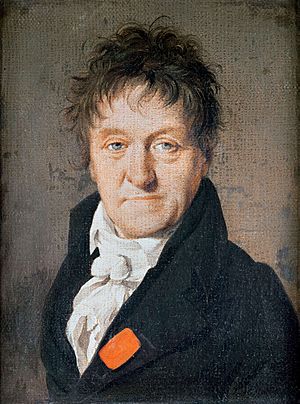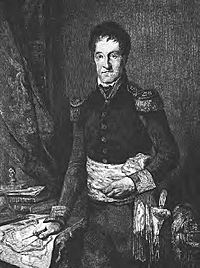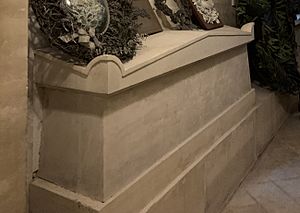Lazare Carnot facts for kids
Quick facts for kids
Lazare Carnot
|
|
|---|---|

Portrait by Louis-Léopold Boilly, 1813
|
|
| 41st President of the National Convention | |
| In office 20 May 1794 – 4 June 1794 |
|
| Preceded by | Robert Lindet |
| Succeeded by | Claude-Antoine Prieur-Duvernois |
| Member of the Committee of Public Safety | |
| In office 14 August 1793 – 6 October 1794 |
|
| Director of the French Directory | |
| In office 4 November 1795 – 5 September 1797 |
|
| Preceded by | None |
| Succeeded by | Philippe-Antoine Merlin de Douai |
| Minister of War | |
| In office 2 April 1800 – 8 October 1800 |
|
| Preceded by | Louis-Alexandre Berthier |
| Succeeded by | Louis-Alexandre Berthier |
| Minister of Interior | |
| In office 20 March 1815 – 22 June 1815 |
|
| Monarch | Napoleon I |
| Preceded by | François-Xavier-Marc-Antoine de Montesquiou-Fézensac |
| Succeeded by | Claude Carnot-Feulin |
| Personal details | |
| Born | 13 May 1753 Nolay, Burgundy |
| Died | 2 August 1823 (aged 70) Magdeburg, Prussia |
| Resting place | Panthéon, Paris |
| Political party | Marais |
| Children | Sadi Carnot Lazare Hippolyte Carnot |
| Profession | Mathematician, engineer, military commander, politician |
| Signature |  |
Lazare Nicolas Marguerite, Count Carnot (French pronunciation: [lazaʁ nikɔla maʁɡəʁit kaʁno]; 13 May 1753 – 2 August 1823) was an important French mathematician, physicist, and politician. He is often called the "Organizer of Victory." This is because he played a huge role in organizing the French armies during the French Revolutionary Wars and Napoleonic Wars. He helped France win many battles.
Contents
Lazare Carnot's Early Life and Schooling
Lazare Carnot was born on May 13, 1753, in a small village called Nolay in Burgundy, France. His father was a local judge. Lazare was the second of seven children. When he was 14, he and his brother went to the Collège d'Autun. There, he studied philosophy and classic subjects. He believed strongly in Stoicism, a philosophy that teaches self-control and strength. He was also very inspired by ancient Roman civilization.
At 15, he left school to study more philosophy, math, and theology. A duke, who was impressed by Lazare's studies, suggested he join the military. In 1770, Carnot went to a special school to prepare for engineering and artillery schools in Paris. In 1771, he was one of the top students chosen to enter the École royale du génie de Mézières. This was a famous engineering school. He studied geometry, mechanics, and hydraulics. He graduated in 1773 as a first lieutenant when he was 18 years old.
Becoming a Military Engineer and Writer
After school, Carnot became a lieutenant in the engineer corps. He quickly became known for his skills in both theoretical engineering and building fortifications (military defenses). While serving in the army in places like Calais and Cherbourg, he kept studying mathematics. In 1783, he was promoted to captain.
In 1784, he published his first book, Essay on Machines. In this book, he wrote about ideas that were similar to the principle of energy. He also showed that kinetic energy (energy of motion) is lost when objects that are not perfectly bouncy hit each other. This book earned him an honor from a famous science academy. He also wrote an essay praising the engineer Sébastien Le Prestre de Vauban, which helped his own career as a writer and engineer. Vauban's ideas greatly influenced Carnot's work as a general and engineer.
In 1786, he met Maximilien Robespierre, who would become a very important figure in the French Revolution. They met in a literary club in Arras. In 1791, Carnot married Sophie Dupont.
Carnot's Political Journey
In September 1791, Lazare Carnot became a representative for Pas-de-Calais in the Legislature. He was chosen to be part of the Committee of Public Instruction. He strongly believed that all citizens should receive an education. He wrote many ideas for improving schools, but they were not put into action because of the chaotic time of the French Revolution.
Joining the National Convention and Committee of Public Safety
In September 1792, Carnot was elected to the National Convention. He spent time in Bayonne, helping to organize France's military defenses against possible attacks from Spain. When he returned to Paris, he voted for the death of King Louis XVI.
On August 14, 1793, Carnot was elected to the Committee of Public Safety. This committee was very powerful during the French Revolution. Carnot took charge of military matters, acting as one of the Ministers of War. He worked to strengthen France's army and defense.
Role in the French Directory
In 1795, the Directory was formed, and Carnot became one of its five leaders. At first, the leaders worked well together. However, their political ideas began to clash. Carnot wanted to end the war and make peace. He was forced out of the Directory in a political event called the Coup of 18 Fructidor in 1797. This event was planned by generals like Napoleon Bonaparte, who Carnot had actually helped earlier in his career. Carnot then went to live in Geneva.
Military Achievements and the "Organizer of Victory"
Carnot was key to creating the strong French Revolutionary Army. He introduced conscription, which meant that many citizens had to join the army. This policy, called the levée en masse, helped increase France's army from 645,000 soldiers in mid-1793 to 1,500,000 by September 1794. He was one of the first to use modern war strategies with large armies and careful planning.
As a military engineer, Carnot liked building strong fortifications. He even designed new defensive walls, like the Carnot wall, named after him. But when France faced constant invasions, he changed his strategy to offensive attacks. His clever plans and organization helped turn the war around from 1793 to 1794. His main idea was to divide the huge army into smaller, faster units. These units could attack the enemy from the sides instead of head-on, which had caused many defeats before. This new tactic worked very well against older European armies. He also made sure new recruits were trained and placed with experienced soldiers.
Once he had enough soldiers, Carnot focused on getting them the supplies they needed. Many supplies were scarce. For example, there wasn't enough copper for guns, so he ordered church bells to be melted down. He also found new ways to get saltpeter and leather for boots. He quickly organized the army and helped change the course of the war. This made him famous as the Organizer of Victory. In 1793, he helped lead French forces on the Northern Front and contributed to a victory at the Battle of Wattignies.
Carnot's Relationship with Robespierre
Carnot first met Maximilien Robespierre in Arras, where they were both members of a literary club. They became friends there.
However, in 1794, when Carnot was on the Committee of Public Safety, tensions grew between him and Robespierre. Carnot signed many decrees, mostly about military plans and education. While he shared some beliefs with the radical Jacobin Club, Carnot was more moderate. He disagreed with Robespierre's idea of a completely equal social system.
Carnot did not try to stop the Reign of Terror, a period of extreme violence. But he and other technical experts on the committee eventually turned against Robespierre. They had him arrested, and Robespierre was later executed. Carnot was briefly accused of wrongdoing during this time, but the charges were dropped when he joined the Directory.
Carnot and Napoleon Bonaparte
In 1795, Carnot appointed Napoleon Bonaparte as the general of the Army of Italy. Carnot was the only member of the Directory who supported Napoleon at this time.
In 1800, Napoleon made Carnot the Minister of War. Carnot served in this role during the Battle of Marengo. However, in 1802, Carnot voted against making Napoleon's power as Consul (leader) last for life and passing it to his children. Carnot believed that if power belonged to one family forever, it would become a dictatorship.
After Napoleon crowned himself emperor in 1804, Carnot, who believed in a republic, left public life. He did not want to serve under an emperor. Later, in 1809, Napoleon asked Carnot to write a book about how to improve fortifications. Carnot developed new ideas for defending forts and allowing counterattacks.
In 1812, Carnot returned to help Napoleon during the difficult invasion of Russia. He was put in charge of defending Antwerp against enemy forces. He only surrendered when the new French king's brother demanded it. Napoleon then made him a Count. During Napoleon's brief return to power in 1815 (the Hundred Days), Carnot served as Minister of the Interior. After Napoleon's final defeat, Carnot was exiled because he had voted for the execution of King Louis XVI.
Retirement and Lasting Impact
In 1803, Carnot published Géométrie de position, a book about projective geometry. He was the first to use "cross-ratios" in geometry, which helped set new foundations for mathematics later on.
Several important ideas in fluid dynamics and geometry are named after him. These include the Borda–Carnot equation and various Carnot's theorems related to triangles and circles.
His book on fortification, "Traité de la Défense des Places Fortes", was published in 1810. Although not all his ideas were widely adopted, the Carnot wall, a special detached wall in forts, became a common feature in the mid-19th century.
Carnot lived in Warsaw and then in Prussia, where he died in Magdeburg. In 1889, his remains were moved to the Panthéon in Paris, a famous building where many French heroes are buried.
Lazare Carnot lived through all the major parts of the French Revolution, from 1789 until Napoleon's fall in 1815. He proposed many reforms to improve France. One of his ideas was for all citizens to have compulsory public education. He also suggested a new Constitution that included a "Declaration of the Duties of the Citizens." This stated that all French citizens between 20 and 25 should have both education and military service. These ideas fit with the revolutionary spirit of the time, which valued a person's ability and intelligence over their birthright, even though Carnot himself came from a noble family.
Carnot's Work in Math and Engineering
Carnot published several important works on engineering theory and mathematics:
- De la corrélation des figures de géométrie (1801): This book contains several theorems in geometry known as Carnot's theorem.
- Principes fondamentaux de l'équilibre et du mouvement (1803): This was a revised and expanded version of his earlier work. It was the first detailed theoretical analysis of engineering mechanics. In it, he studied how energy moves within mechanical systems. He found that power is transferred best when things like friction are kept very low. This was an early step towards understanding the law of conservation of energy.
Carnot's son, Nicolas Léonard Sadi Carnot, was inspired by his father's work. This inspiration led him to research the efficiency of steam engines, which became a key part of the field of thermodynamics.
Lazare Carnot's name is one of the 72 names carved on the Eiffel Tower in Paris, honoring his contributions to France.
Famous Family Members
Lazare Carnot's family continued to be important figures in French history:
- His son, Sadi Carnot, is considered a founder of thermodynamics, the study of heat and energy. He developed the theory of heat engines (see Carnot cycle).
- His second son, Lazare Hippolyte Carnot, was also a French statesman (a leader in government).
- His grandson, Marie François Sadi Carnot (Hippolyte's son), became President of the French Republic from 1887 until he was assassinated in 1894.
Images for kids
See also
 In Spanish: Lazare Carnot para niños
In Spanish: Lazare Carnot para niños








